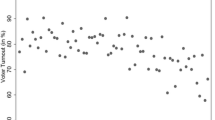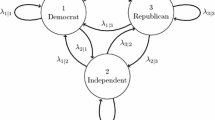Abstract
This paper discusses the individual dynamics of Congressional party voting in terms of a cohort model. Like previous studies, which have used a different terminology (Asher and Weisberg, 1978), stability and replacement are major factors. Smaller, yet significant conversions were also found in regard to the impact of the seniority system and the committee system in allowing independence from the parties. Lastly, major period effects were also revealed. While period effects are more a chance occurrence than conversion associated with accumulating seniority, they may prove significant in understanding the dynamics of congressional voting as stability processes pick up and structure the period effects. In other words, the effects of period disturbances may persist long after the period has ended, as stabilizing processes capture the period changes and make these period changes a part of the congress's future.
Similar content being viewed by others
References
Abramowitz, Alan (1980). “Is the Revolt Fading? A Note on Party Loyalty Among Southern Democratic Congressmen.”Journal of Politics 42: 568–72.
Asher, Herbert B. (1973). “The Learning of Legislative Norms.”American Political Science Review 67: 499–513.
——, and Herbert Weisberg (1978). “Voting Change in Congress: Some Dynamic Perspectives on an Evolutionary Process.”American Journal of Political Science 22: 391–425.
Brady, David, Joseph Cooper, and Patricia Hurley (1979). “The Decline of Party in the U.S. House of Representatives.”Legislative Studies Quarterly 4: 381–408.
——, and Naomi Lynn (1973). “Switched-Seat Congressional Districts: Their Effect on Party Voting and Public Policy.”American Journal of Political Science 17: 528–43.
Clausen, Aage R. (1973).How Congressmen Decide: A Policy Focus. New York: St. Martin's.
Clubb, Jerome, and S. Traugott (1977). “Partisan Cleavage and Cohesion in the House of Representatives, 1861–1974.”Journal of Interdisciplinary History 7: 375–401.
Cooper, Joseph, and Gary Bombardier (1968). “Presidential Leadership and Party Success.”Journal of Politics 30: 1012–27.
——, David Brady, and Patrici Hurley (1977). “The Electoral Basis of Party Voting: Patterns and Trends in the U.S. House of Representatives, 1887–1969.” In Louis Maisel and Joseph Cooper (Eds.),The Impact of the Electoral Process. Beverly Hills, CA: Sage, pp. 133–65.
Deckard, Barbara, and John Stanley (1974). “Party Decomposition and Region: The House of Representatives, 1945–70.”Western Political Quarterly 27: 249–64.
Glenn, Norval (1977). “Cohort Analysis.” Sage University Paper Series on Quantitative Applications in the Social Sciences, 04-005. Beverly Hills: Sage.
Hinckley, Barbara (1970).The Seniority System in Congress. Bloomington, Ind.: Indiana University Press.
Kesselman, Mark (1961). “Presidential Leadership in Congress on Foreign Policy,”Midwest Journal of Political Science 5: 284–89.
—— (1965). “Presidential Leadership in Congress on Foreign Policy: A Replication of a Hypothesis.”Midwest Journal of Political Science 9: 401–6.
Key, V. O. (1949).Southern Politics. New York: Vintage.
Matthews, Donald R., and James Stimson (1975).Yeas and Nays: Normal Decision Making in the U.S. House of Representatives. New York: Wiley.
Mayhew, David (1966).Party Loyalty Among Congressmen. Cambridge, Mass.: Harvard.
——, (1974). “Congressional Elections: The Case of the Vanishing Marginals.”Polity 6: 295–317.
Nelson, Garrison (1977). “Partisan Patterns of House Leadership in Congress, 1789–1977.”American Political Science Review 71: 918–39.
Peabody, Robert L. (1976).Leadership in Congress. Boston: Little Brown.
Shannon, Wayne (1968).Party, Constituency, and Congressional Voting. Baton Rouge, La.: Louisiana State University Press.
Stone, Walter (1980). “The Dynamics of Constituency: Electoral Control in the House.”American Politics Quarterly 8: 399–424.
Truman, David (1959).The Congressional Party. New York: Wiley.
Walker, Jack L. (1977). “Setting the Agenda in the U.S. Senate: A Theory of Problem Selection.”British Journal of Political Science 7: 423–45.
Weinbaum, Marvin, and Dennis R. Judd (1970). “In Search of a Mandated Congress.”Midwest Journal of Political Science 14: 276–302.
Weisberg, Herbert (1978). “Evaluating Theories of Congressional Roll-Call Voting.”American Journal of Political Science 22: 554–77.
Author information
Authors and Affiliations
Rights and permissions
About this article
Cite this article
Cohen, J. The dynamics of party voting in congress, 1955–78: A cohort model. Polit Behav 3, 211–227 (1981). https://doi.org/10.1007/BF00990096
Issue Date:
DOI: https://doi.org/10.1007/BF00990096




